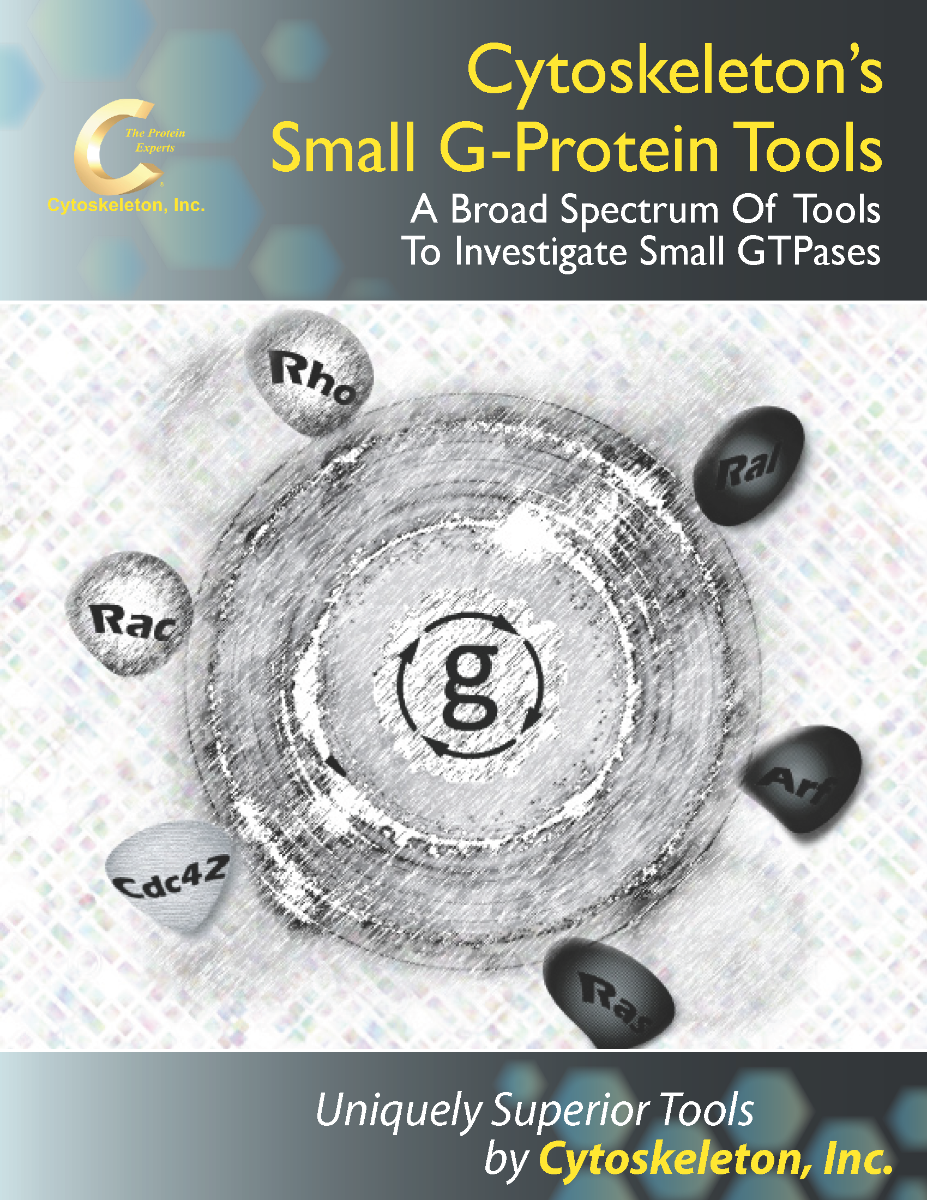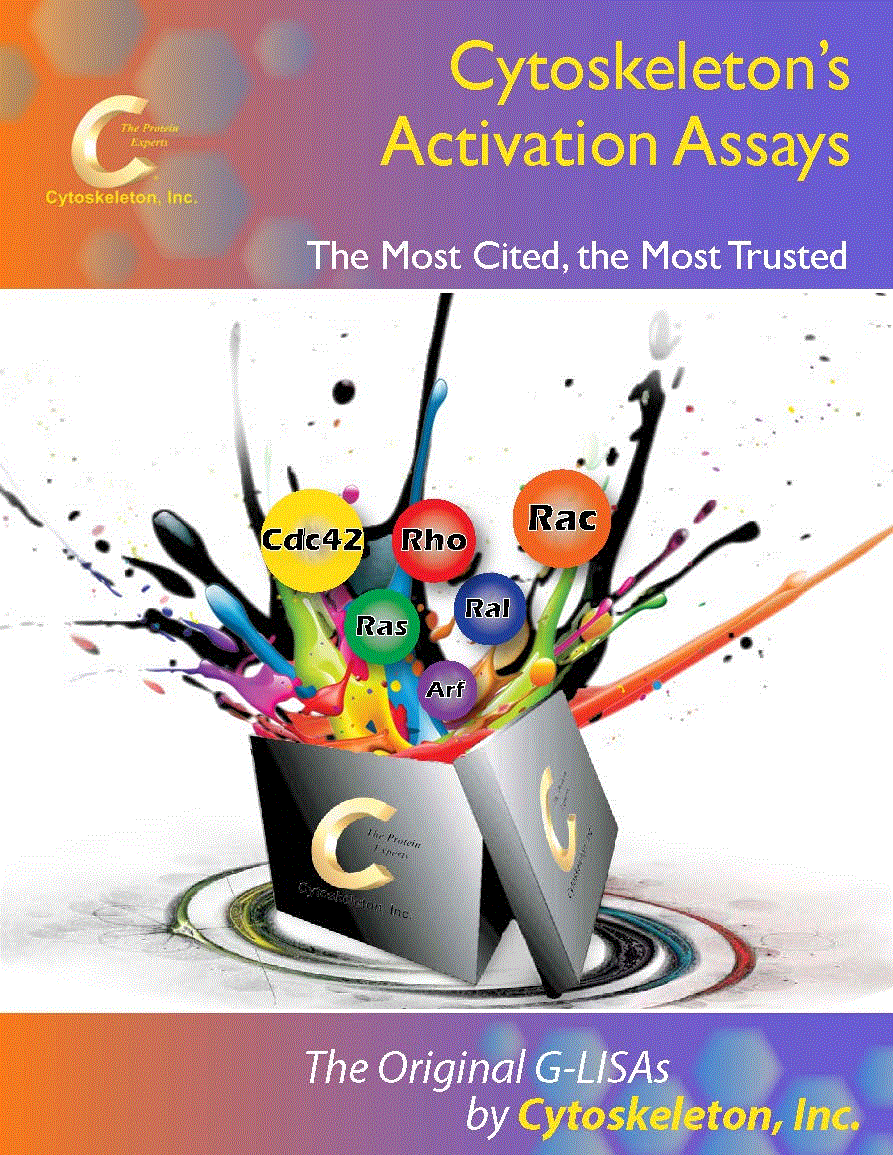Small G-Protein and Activation Assay Information
The Ras superfamily of small GTPases consists of more than 150 members such as Rho, Ras, Ran, Rab, and Arf. Small GTPases serve as binary switches cycling between GDP-bound inactive and GTP-bound active states and have been shown to regulate biological processes including cell growth, cell differentiation, and cell movement. Dysfunction of small G-proteins has been identified in several diseases such as cancer, cardiovascular, and neurological disorders.
Cytoskeleton, Inc. has a wide assortment of Small G-protein tools and reagents including our trusted and highly cited Activation Assays. We've created a simple explanation video, as well as newsletters and citation spotlights to provide insight about these critical regulatory proteins and the helpful tools used to investigate them. If you have any questions about a particular product or toolkit please send an email to cserve@cytoskeleton.com.
Learn More About These Regulatory Small-G Proteins
Our most recent Small G-Protein writings can be found below. However Cytoskeleton has been writing about Small G-Proteins for years, and that library of information can be found here
Oncogenic RAS Signaling And Tumor Immune Evasion: Mechanisms And Therapeutic Opportunity
Oncogenic RAS drives cells to the cancerous state through a wide range of mechanisms, including: the establishment of cancer cell plasticity (1), enhancement of cell migration and metastasis (2) and metabolic reprogramming towards anabolic metabolism (3). This Newsletter focuses on the emerging area of RAS driven oncogenesis via the evasion of host immune attack. Cancerous cells are visible to the host immune system through chronic stress signals and tumor associated antigen presentation and are therefore susceptible to being cleared from the host via immunogenic mechanisms. Many RAS driven cancers have a high mutational burden and should be good targets for immune clearance, however, oncogenic RAS has evolved mechanisms to suppress the immune response and promote tumor growth. A brief overview of the major mechanisms is summarized in the newsletter.
Stick It To RAS: The Next Wave Of RAS Therapeutics
The small GTPase RAS protein is a critical molecular switch that cycles between GTP-bound (active) and GDP-bound (inactive) states. For much of the last 40 years, RAS was deemed undruggable due to its “smooth” surface with no obvious drug-binding features. In 2021, that changed when work pioneered by the Shokat group2 led to the first approved KRAS targeting drugs, sotorasib and adagrasib. These drugs function by covalently binding to GDP-bound KRAS-G12C mutants. The impact of this scientific breakthrough has been twofold – 1) in the clinic where it has had a tremendous impact on KRAS-G12C-dependent cancers and 2) it has muted the idea That KRAS is an undruggable target. Unfortunately, these drugs can’t target wild-type KRAS and other KRAS mutants, such as KRAS G12D which occurs at a higher rate than KRAS-G12C, for example (reviewed in 3). Several new RAS targeting approaches are in development, and this newsletter will discuss some of these technologies that may lead to the next generation of novel RAS therapeutics.
Small G-Protein Tools In Action - Citation Spotlights
Mechanosensitive Smooth Muscle Cell Phenotypic Plasticity Emerging From A Null State And The Balance Between Rac And Rho
Ral GTPases Promote Breast Cancer Metastasis By Controlling Biogenesis And Organ Targeting Of Exosomes
Vascular smooth muscle cells (VSMCs) oscillate between a differentiated (contractile) and a de-differentiated (synthetic) phenotype. In a healthy, mature vessel these VSMCs exist in a differentiated phenotype that comprises the portion of the vessel that contracts to help transport oxygenated blood; conversely, in response to injury, VSMCs can de-differentiate into a synthetic phenotype where they become proliferative and contribute to wound healing. In a recent study by Talwar et al., the group discovered that VSMCs, under selective ECM conditions, can also exist in a null state and can be driven towards the conventional differentiated or de-differentiated phenotypes in response to Rac and Rho signaling. The group used a combination of mathematical and computational modeling to identify a null VSMC phenotype. They then utilized single cell experimental validation approaches ...
Metastasis is a fundamental hallmark of cancer and the most closely aligned with poor prognosis. The mechanisms that regulate metastasis; in particular, the cancer cell’s ability to communicate with the tumor microenvironment to colonize at distinct, distal organ sites remain an intense area of investigation. Recent studies suggest both soluble molecules as well as extracellular vesicles (EV) can play important roles towards seeding the pre-metastatic niche and creating a favorable tumor microenvironment for metastatic cancer cells. Preliminary work by Hyenne et al. identified Ral A/B as a participant in EV secretion in aggressive 4T1 mammary tumor cells; however, whether these EVs play a role in metastasis remained unknown. In this recent study, Ghoroghi et. al. identified Ral A/B as critical regulator of metastasis through control of exosome secretion and biogenesis.
Please visit our product pages for product specific citations - some go back to 1993
RhoA Activation Assay - Rac1 Activation Assay - Ras Activation Assay
Below are Brochures on the Small G-Protein and Activation Assay Tools
Small G-Protein Tools Brochure
Cytoskeleton, Inc. offers a large selection of highly pure and biologically active actin proteins, actin binding proteins, antibodies, buffers and research Biochem Kits™. Our Actin Biochem Kits allow researchers easy access to some of the most powerful in vivo and in vitro assays employed in the field.
Cytoskeleton's Small G-protein Activation Assays measure the GTP-bound form of the protein from a cell or tissue extract and are the most trusted and cited activation assays available. Activation assays are available in two formats: the traditional pull-down bead format and our advanced ELISA based G-LISA format.
Have a technical question about our tools? Send us an email at tservice@cytoskeleton.com and our experts will anwser any question you may have!






